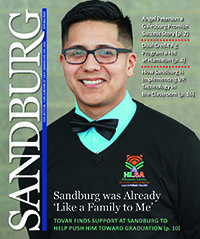A New Reality in Education: How Sandburg is Implementing VR Technology in the Classroom
Aaron Frey
Friday, March 27, 2020 5:03 PM
Campus News
Galesburg, IL
Nancy Kartawich finished giving a speech and turned to the person next to her.
“The lady in the first row doesn’t like me,” Kartawich said.
But this was no ordinary presentation and no ordinary woman in the front row. Kartawich had been using a headset with a virtual reality technology software called Ovation. The woman in the first row was one of the avatars Kartawich had been speaking to in the virtual space.
“That’s how realistic she was to reacting to everything I did and said,” Kartawich said. “I thought it was absolutely incredible.”
Kartawich, an adjunct instructor at Carl Sandburg College, knew right away she wanted to incorporate it in her Intro to Public Speaking class the following semester.
“This was absolutely irresistible because it seemed like such a painless way or even a fun way to get people in there and using it,” Kartawich said. “The first time I saw it, I knew: Get them in there.”
Coordinator of instructional technology Cindy Arthur purchased the Ovation software after testing it out at a conference last year. In it, users put on a headset and hold a controller in each hand while giving a speech or presentation in front of a virtual reality audience. Afterward, they can play back their speech and receive a report with grades and analytics for things such as their use of filler words, a breakdown of their gaze distribution and the amount of eye contact they made. Arthur knew immediately it could be a popular and useful tool for students, and Kartawich felt the same after Arthur showed it to her last year.
“I think (students) go in thinking this is not going to be a big deal,” Arthur said, “but once they put the headset on and see people staring at them and can look around in a 360-degree environment, they still have this ‘wow’ moment. To still get that sort of reaction from an 18- or 19-year-old is pretty cool.”
The software — which is set up in a room inside the Sandburg library — is customizable, allowing the user to select from settings such as a one-on-one meeting, board rooms, lecture halls and large conventions. It also gives feedback in real-time. Ignore an area of the room for too long or use a filler word such as “um” or “uh” and a notification will pop up on the screen. Even a speaker’s hand gestures are analyzed.
“I found out that my right hand goes crazy when I’m presenting and moves all over the place, but my left one doesn’t at all,” said Brayden Bledsoe, whose public speaking class with Kartawich in the fall semester was one of the first to use it in a classroom setting. “I didn’t even think about it, but now I do and I’ve gotten better.”
Kartawich had everyone in her class practice giving a speech using Ovation during the first part of the semester and had them review their report. They used Ovation again later in the semester to measure their progress, and she asked them on the final exam to discuss the strides they thought they made. The students, Kartawich said, took to it “like little duckies to the pond.”
“It gave me the mentality that if I can do it in front of a fake audience, I can do it in front of a real audience,” said Clara Cramer, another one of Kartawich’s students.
Caleb Plattner, also from Kartawich’s class, said the VR experience was valuable, especially since he plans to become a pastor. Plattner said the data he got back from Ovation was more helpful than simply practicing in front of a mirror or recording himself in front of a computer.
“Normally I think of VR as some sort of gaming system or entertainment that you explore with, but combining it with speaking was a really strange combination that worked quite well, actually,” Plattner said. “You never realize how realistic the graphics are until you actually put it on. This felt like you were in an actual classroom instead of just in the library with the headset on.”
Kartawich said the ability to get instant notifications and a follow-up report with objective data makes the VR software a more reliable judge than someone a speaker may have an existing relationship with. Virtual reality, after all, doesn’t have to worry about being dishonest.
“Where do you get that? Not from grandma, not from your roommate. This is real stuff that’s going to make a difference,” Kartawich said. “That virtual reality has no skin in the game. It’s not worried about complimenting you or hurting your feelings.”
Using the software in a public speaking class was logical, but the next step, Arthur said, is to expand it to other classes and departments at the College. Creating mock job interviews or having criminal justice students use it as a virtual courtroom are some of the possibilities. Cramer, a dual credit student from Galesburg High School, said using Ovation would be helpful for her to prepare for college entrance interviews and that she would “hands-down” use it again.
“It is a learning experience like no other,” Cramer said. “You have the ability to create a virtual reality that you can use to gauge learning over periods of time, from start to end. It’s important to have that timeframe to see how far you’ve come.”
READ THIS STORY AND MORE IN THE 2020 EDITION OF SANDBURG MAGAZINE